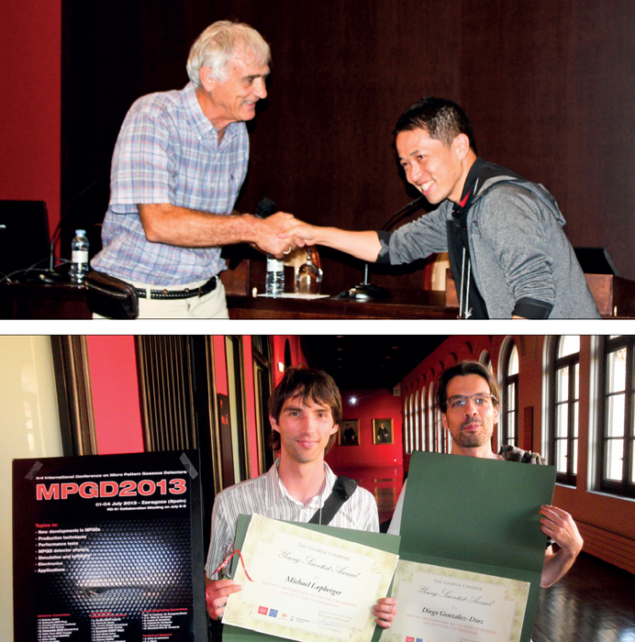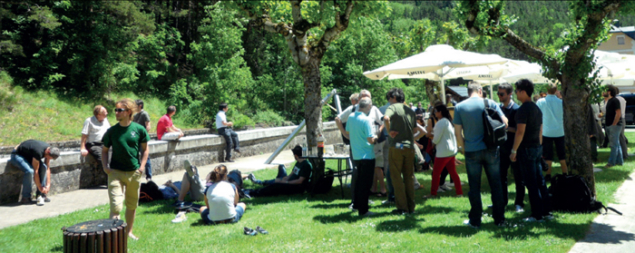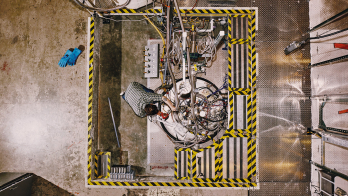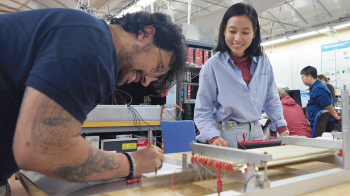Latest research developments in the technology of MPGDs.

Image credit: J Kaminski.
Micropattern gaseous detectors (MPGDs) are the modern heirs of multiwire proportional counter (MWPC) planes, with the wires replaced by microstructures that are engraved on printed-circuit-like substrates. An idea that was first proposed by Anton Oed in 1988, it was the invention of stable amplification structures such as the micromesh gaseous structure (Micromegas) by Ioannis Giomataris in 1996 and the gas electron multiplier (GEM) by Fabio Sauli in 1997 that triggered a boom in the development and applications of these detectors. It was as a consequence of this increasing activity that the series of international conferences on micropattern gaseous detectors was initiated, with the first taking place in Crete in 2009 followed by the second meeting in Kobe in 2011.
The third conference – MPGD2013 – moved to Spain, bringing more than 125 physicists, engineers and students to the Paraninfo building of the Universidad de Zaragoza during the first week of July. The presentations and discussions took place in the same room that, about a century ago, Santiago Ramón y Cajal – the most prominent Spanish winner of a scientific Nobel prize – studied and taught in. The Paraninfo is the university’s oldest building and its halls, corridors and stairs provided an impressive setting for the conference. The streets, bars and restaurants of Zaragoza – the capital of Aragon – were further subjects for the conference participants to discover. After an intense day of high-quality science, lively discussions often continued into the evening and sometimes late into the night, helped by a variety of tapas and wines.
The wealth of topics and applications that were reviewed at the conference reflected the current exciting era in the field. Indeed, the large amount of information and number of projects that were presented make it difficult to summarize the most relevant ones in a few lines. The following is a personal selection. Readers who would like more detail can browse the presentations that are posted on the conference website, including the excellent and comprehensive conference-summary talk given by Silvia Dalla Torre of INFN/Treiste on the last day.
The meeting started with talks about experiments in high-energy and nuclear physics that are using (or planning to use) MPGDs. Since the pioneering implementation of GEM and Micromegas detectors by the COMPASS collaboration at CERN – the first large-scale use of MPGDs in high-energy physics – they have spread to many more experiments. Now all of the LHC experiment collaborations plan to install MPGDs in their future upgrades. The most impressive examples, in terms of detector area, are the 1200 m2 of Micromegas modules to be installed in the muon system of ATLAS and the 1000 m2 of GEM modules destined for the forward muon spectrometer of CMS. These examples confirm that MPGDs are the technology of choice when large areas need to be covered with high granularity and occupancy in a cost-effective way. These numbers also imply that transferring the fabrication know-how to industry is a must. A good deal of effort is currently devoted to industrialization of MPGDs and this was also an important topic at the conference.
MPGDs have found application in other fields of fundamental research. Some relevant examples that were discussed at the conference included their use as X-ray or γ detectors or as polarimeters in astrophysics, as neutron or fission-fragment detectors, or in rare-event experiments. Several groups are exploring the possibility of developing MPGD-based light detectors – motivated greatly by the desire to replace large photo-multiplier tube (PMT) arrays in the next generation of rare-event experiments. Working at cryogenic temperatures – or even within the cryogenic liquid itself – is sometimes a requirement. Large-area light detectors are also needed for Cherenkov detectors and in this context presentations at the conference included several nice examples of Cherenkov rings registered by MPGDs. Several talks reported on applications beyond fundamental research, including a review by Fabrizio Murtas of INFN/Frascati and CERN. MPGDs are being used or considered in fields as different as medical imaging, radiotherapy, material science, radioactive-waste monitoring and security inspection, among others.

Image credit: S Cebrián.
An important part of the effort of the community is to improve the overall performance of current MPGDs, in particular regarding issues such as ageing or resilience to discharges. This is leading to modified versions of the established amplification structures of Micromegas and GEMs and to new alternative geometries. Some examples that were mentioned at the conference are variations that go under the names of μ-PIC, THGEM, MHSP or COBRA, as well as configurations that combine several different geometries. In particular, a number of varieties of thick GEM-like (THGEM) detectors (also known as large electron multipliers, or LEM) are being actively developed, as Shikma Bressler of the Weizmann Institute of Science described in her review.
Many of the advances that were presented involve the use of new materials – for example, a GEM made out of glass or Teflon – or the implementation of electrodes with resistive materials, the main goal being to limit the size and rate of discharges and their potential damage. Advances on the GridPix idea – the use of a Micromegas mesh post-processed on top of a Timepix chip – also go in the direction of adding a resistive layer to limit discharges and attracted plenty of interest. Completely new approaches were also presented, such as the “piggyback Micromegas” that separates the Micromegas from the actual readout by a ceramic layer, so that the signal is read by capacitive coupling and the readout is immune to discharges.
Several senior members gave advice to the new generation of MPGD researchers and proposed a toast to them
The presence of CERN’s Rui de Oliveira to review the technical advances in MPGD fabrication techniques and industrialization is already a tradition at these meetings. Current efforts focus on the challenges presented by projects that require GEM and Micromegas detectors with larger areas. Another tradition is to hear Rob Veenhof of Uludağ University and the RD51 collaboration review the current situation in the simulation of electron diffusion, amplification and signal detection in gas, as well as the corresponding software tools. Current advances are allowing the community to understand progressively the performance of MPGDs at the microphysics level. Finally, although electronics issues were present in many of the talks, the participants especially enjoyed a pedagogical talk by CERN’s Alessandro Marchioro about the trends in microelectronics and how they might affect future detectors in the field. These topics were studied in more detail in the sessions of the RD-51 collaboration meeting that came after the conference at the same venue. Fortunately, there was the opportunity to relax before this following meeting, with a one-day excursion to the installations of the Canfranc Underground Laboratory in the Spanish Pyrenees and St George’s castle in the town of Jaca.
The vitality of the MPGD community resides in the relatively large number of young researchers who came to Zaragoza eager to present their work as a talk or as one of the 40 posters that were displayed in the coffee and lunch hall during the week. Three of those young researchers – Michael Lupberger of the University of Bonn, Diego González-Díaz of the University of Zaragoza and Takeshi Fujiwara of the University of Tokyo – received the Charpak Prize to reward their work. This award was first presented at MPGD2011 in Japan and the hope is that it becomes formally established in the MPGD community on future occasions.
Time will tell which of the many ideas that are now being put forward will eventually become established but the creativity of the community is remarkable and one of its most important assets. References to this creativity – and to the younger generation of researchers who foster it – were recurrent throughout the conference. At the banquet, by the Ebro riverbank under the shadow of the tall towers of the Basílica del Pilar, several senior members gave advice to the new generation of MPGD researchers and proposed a toast to them – a blessing for the field.








